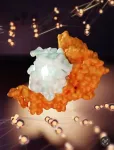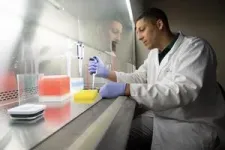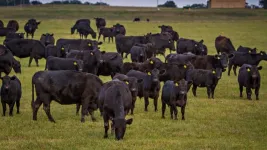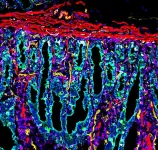(Press-News.org) Have you ever wondered why some people never became sick from COVID-19? A study published today in Nature shows that common genetic variation among people is responsible for mediating SARS-CoV-2 asymptomatic infection. The results indicate that individuals having this variant never feel sick once infected. This exciting discovery was a result of a U.S.-Australia collaborative work led by Danillo Augusto, Ph.D., assistant professor at the University of North Carolina at Charlotte; Jill Hollenbach, Ph.D., professor at the University of California San Francisco; and Stephanie Gras, professor at La Trobe University in Australia.
The study focuses on a group of genes called human leukocyte antigens (HLA). These HLA genes code for proteins used by the immune system to identify your healthy cells and distinguish them from those infected by bacteria and viruses. The HLA system is critical for immune response and also highly variable among individuals. Because of the role of HLAs in fighting infection, the researchers wondered if there were specific variants that would make us more protected or susceptible to SARS-CoV-2 virus.
Hollenbach led the data collection, which started at the beginning of the pandemic. First, 29,947 unvaccinated individuals were screened using a mobile app designed specifically to track COVID-19 symptoms, and 1,428 reported a positive test for the virus. All individuals had their DNA previously sequenced to analyze their HLA genes. The researchers found that individuals having the genetic variant HLA-B*15:01 were much more likely to remain asymptomatic after infection. Impressively, this variant is present in about 10% of the population. In summary, individuals who had HLA-B*1501 in their genome could not dodge the infection, however they escaped being sick.
"We hypothesized that their immune system could react so fast and powerfully that the virus was eliminated before causing any symptoms. It’s like having an army that already knows what to look for and can tell by the uniform that these are the bad guys," according to Hollenbach.
HLA molecules display pieces of the virus to immune effector cells for inspection. The study used cells from individuals with HLA-B*15:01 who donated blood several years before the pandemic. The results showed that those individuals had memory T cells against a specific particle of SARS-CoV-2. Individuals who never had any contact with SARS-CoV-2 had already had some kind of previous exposure to other viruses and developed immunological memory against a particle from SARS-CoV-2. Their immunological memory would elicit a much faster response and explain why those individuals remained asymptomatic. Still, it remained intriguing how they could develop immunological memory against SARS-CoV-2 without ever being exposed to this virus.
"It is widely known that other types of coronaviruses have caused seasonal colds for decades. We hypothesized that these individuals were exposed to seasonal coronaviruses in the past, and somehow, individuals specifically carrying HLA-B*15:01 could quickly kill cells infected by SARS-CoV-2 due to cross-reactive immunological responses. So, even if the bad guys changed the uniform, the army would still be able to identify them by their boots or maybe a tattoo on their arms. That is how our immunological memory works to keep us healthy,” said Augusto.
After carefully analyzing the genomic sequences of all coronaviruses, the study showed that this SARS-CoV-2 particle recognized by HLA-B*15:01 in unexposed individuals is very similar to viral particles from other previous coronaviruses. The research demonstrated that T cells from pre-pandemic individuals could identify viral particles from past coronaviruses and SARS-CoV-2 with the same efficiency by showing crystal structures and affinity assays. It means those individuals created immunological memory for the previous coronaviruses, but because of the high similarity of this viral particle, their memory T cells can also recognize and kill SARS-CoV-2 very fast.
The results show a mechanism for how individuals can avoid being sick from SARS-CoV-2 and the research group plans to continue learning about the response against this virus, which will result in better understanding of COVID-19 therapeutics and vaccines.
END
Genetics explains why some individuals never have COVID-19 symptoms
New study shows that common genetic variation among people is responsible for mediating SARS-CoV-2 asymptomatic infection
2023-07-19
ELSE PRESS RELEASES FROM THIS DATE:
Unveiling the quantum dance: Experiments reveal nexus of vibrational and electronic dynamics
2023-07-19
Nearly a century ago, physicists Max Born and J. Robert Oppenheimer developed an assumption regarding how quantum mechanics plays out in molecules, which are comprised of intricate systems of nuclei and electrons. The Born-Oppenheimer approximation assumes that the motion of nuclei and electrons in a molecule are independent of each other and can be treated separately.
This model works the vast majority of the time, but scientists are testing its limits. Recently, a team of scientists demonstrated the breakdown ...
Gender disparities in Lyme disease: Women face higher risk of severe and prolonged illness
2023-07-19
Women with Lyme disease take longer to get diagnosed, have more severe symptoms and experience higher rates of disability when compared to men. They may also be more likely to develop persistent Lyme disease. Those are among the findings of a recent study that analyzed information from the MyLymeData patient registry. The results have been published in the International Journal of General Medicine.
The present study, which was conducted by LymeDisease.org, a research and advocacy organization, assessed sex-based differences in Lyme disease patients who remained ill for six months or more after antibiotic treatment. In ...
New study uses gene prediction tool to select premium grade Angus herds in Missouri and across the United States
2023-07-19
Ranches across the Show-Me State manage approximately two million cattle — a significant number of which are Angus, a top-tier breed that has unrivaled success in the commercial beef market. In a new study, University of Missouri researcher Jared Decker and Thompson Research Farm tested a group of commercial Angus cows using a commercial genomic prediction tool called Zoetis GeneMax Advantage to investigate the ability of the test to predict their calves’ performance and profitability. This project demonstrates ...
Tracing maternal behavior to brain immune function
2023-07-19
COLUMBUS, Ohio – Immune system changes in the pregnant body that protect the fetus appear to extend to the brain, where a decrease in immune cells late in gestation may factor into the onset of maternal behavior, new research in rats suggests.
In adult female rats that had never given birth – which typically don’t like being around babies – depletion of these cells sped up their care for rat newborns that were placed in their cage.
The loss of these cells, called microglia, and the related uptick in motherly attentiveness were also associated with changes to neuron activity in several regions of the rat brain, suggesting ...
Stanford Medicine researchers map morphing placenta
2023-07-19
Early in pregnancy, something strange happens in the uterus: Cells from the fetal side of the developing placenta invade the uterine endometrium and work with the mother’s immune system to remodel the arteries.
“When I first read about it, I thought, ‘This is so bizarre,’” said Stanford Medicine pathologist Michael Angelo, MD, PhD.
Humans’ immune systems usually attack unfamiliar cells, which would theoretically pose a problem for a developing pregnancy. But on the mother’s side of the growing placenta, the arteries incorporate cells that genetically match the embryo, just one of ...
It’s a beautiful day in the intestinal neighborhood
2023-07-19
When you think about your ideal neighborhood, perhaps you think of tree-lined streets or a close-knit community of people who help each other. You probably don’t think about your digestive system.
But maybe you should. According to a team of scientists led by researchers at Stanford Medicine, there are indeed “neighborhoods” of different cell types cooperating to digest your food and protect you from infection, among other things — and a new, ultra-high-resolution map of these neighborhoods proves your intestine is both functionally impressive and visually striking.
Just like human neighborhoods, ...
UTHealth Houston study on seasonality of teen suicidality in JAMA Network Open
2023-07-19
The incidences of teen suicidality including self-harm, suicidal ideation, and suicide attempts increased nationally between 2016 and 2021; were at seasonal high peaks in April and October; and were at their lowest when schools were shut down during the COVID-19 pandemic, according to research at UTHealth Houston.
The study was published this month in JAMA Network Open. It was authored by Youngran Kim, PhD, assistant professor in the Department of Management, Policy, and Community Health at UTHealth Houston School of Public Health; Scott D. Lane, PhD, professor and vice chair for research in the Louis A. Faillace, MD, Department of Psychiatry and Behavioral ...
NASA funds 3 citizen science projects to study 2024 U.S. solar eclipse
2023-07-19
NASA has awarded funding for three science teams to conduct citizen science investigations as a total solar eclipse sweeps across North America on April 8, 2024. In these experiments, volunteers will help study the Sun and its ethereal outer atmosphere, called the corona, which is revealed when the Moon completely covers the Sun’s bright disk.
“During next year’s total eclipse, hundreds of volunteers will capture images of the Sun and its corona to help answer real science question about our star and how it affects us,” said program scientist and eclipse lead at NASA Headquarters, ...
Association between markers of structural racism and mass shooting events in major US cities
2023-07-19
About The Study: This study found that major U.S. cities with higher populations of Black individuals are more likely to be affected by mass shooting events, suggesting that structural racism may have a role in their incidence. Public health initiatives aiming to prevent mass shooting events should target factors associated with structural racism to address gun violence.
Authors: Michael Ghio, M.D., of Tulane University in New Orleans, is the corresponding author.
To access the embargoed study: Visit our For The Media website at this link https://media.jamanetwork.com/
(doi:10.1001/jamasurg.2023.2846)
Editor’s ...
Trends, seasonality of emergency department visits, hospitalizations for suicidality among children and adolescents
2023-07-19
About The Study: The findings of this study of 73,000 emergency department visits and hospitalizations for suicidality indicated the presence of seasonal patterns and an observed unexpected decrease in suicidality among children and adolescents after COVID-19–related school closures in March 2020, which suggest a potential association between suicidality and the school calendar.
Authors: Scott D. Lane, Ph.D., of the University of Texas Health Science Center at Houston, is the corresponding author.
To access the embargoed study: Visit ...
LAST 30 PRESS RELEASES:
Geometry shapes life
A CRISPR screen reveals many previously unrecognized genes required for brain development and a new neurodevelopmental disorder
Hot flush treatment has anti-breast cancer activity, study finds
Securing AI systems against growing cybersecurity threats
Longest observation of an active solar region
Why nail-biting, procrastination and other self-sabotaging behaviors are rooted in survival instincts
Regional variations in mechanical properties of porcine leptomeninges
Artificial empathy in therapy and healthcare: advancements in interpersonal interaction technologies
Why some brains switch gears more efficiently than others
UVA’s Jundong Li wins ICDM’S 2025 Tao Li Award for data mining, machine learning
UVA’s low-power, high-performance computer power player Mircea Stan earns National Academy of Inventors fellowship
Not playing by the rules: USU researcher explores filamentous algae dynamics in rivers
Do our body clocks influence our risk of dementia?
Anthropologists offer new evidence of bipedalism in long-debated fossil discovery
Safer receipt paper from wood
Dosage-sensitive genes suggest no whole-genome duplications in ancestral angiosperm
First ancient human herpesvirus genomes document their deep history with humans
Why Some Bacteria Survive Antibiotics and How to Stop Them - New study reveals that bacteria can survive antibiotic treatment through two fundamentally different “shutdown modes”
UCLA study links scar healing to dangerous placenta condition
CHANGE-seq-BE finds off-target changes in the genome from base editors
The Journal of Nuclear Medicine Ahead-of-Print Tip Sheet: January 2, 2026
Delayed or absent first dose of measles, mumps, and rubella vaccination
Trends in US preterm birth rates by household income and race and ethnicity
Study identifies potential biomarker linked to progression and brain inflammation in multiple sclerosis
Many mothers in Norway do not show up for postnatal check-ups
Researchers want to find out why quick clay is so unstable
Superradiant spins show teamwork at the quantum scale
Cleveland Clinic Research links tumor bacteria to immunotherapy resistance in head and neck cancer
First Editorial of 2026: Resisting AI slop
Joint ground- and space-based observations reveal Saturn-mass rogue planet
[Press-News.org] Genetics explains why some individuals never have COVID-19 symptomsNew study shows that common genetic variation among people is responsible for mediating SARS-CoV-2 asymptomatic infection





